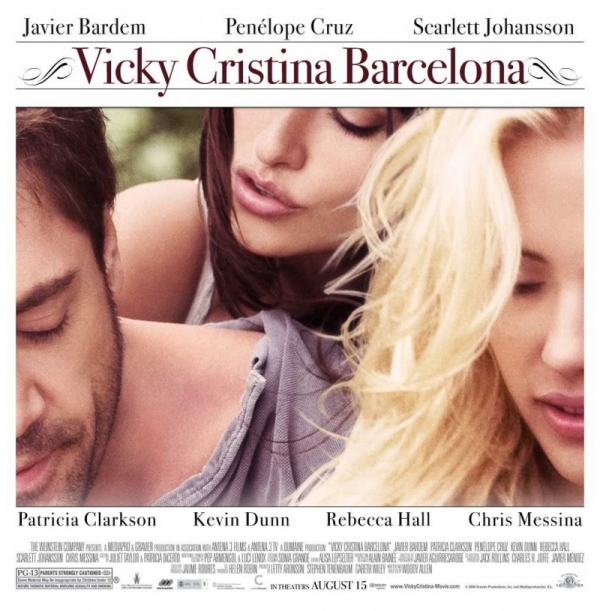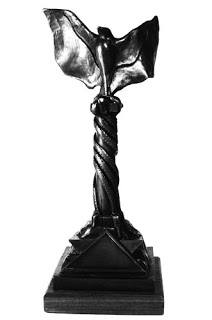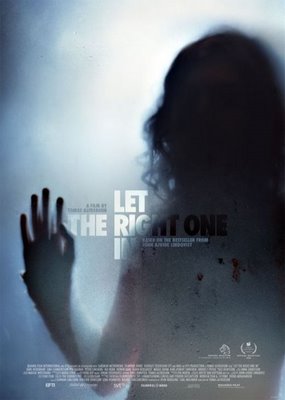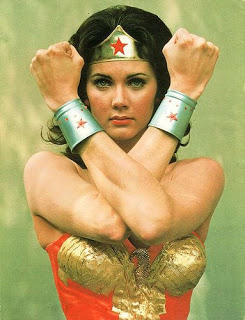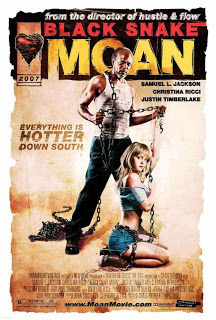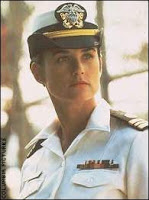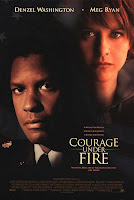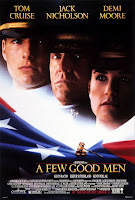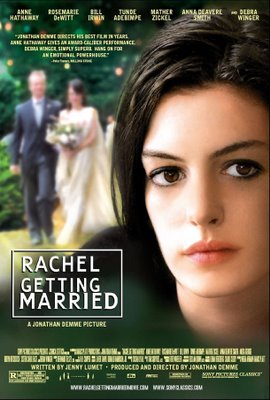Click on the thumbnails to bring up reviews about each of the films!
2009 Spirit Award Nominees
 If you thought the previous two posts were repetitive, here’s something different. The Film Independent’s Spirit Awards air the day before the Academy Awards, February 21, on the IFC.
If you thought the previous two posts were repetitive, here’s something different. The Film Independent’s Spirit Awards air the day before the Academy Awards, February 21, on the IFC.
Film Independent is everything the Academy is not. Notice their description:
Film Independent is an open enrollment and non-profit membership organization that champions independent film and supports a community of artists who embody diversity, innovation, and uniqueness of vision. Film Independent helps fimmakers make their movies, builds the audience for their projects, and works to diversify the film industry. Anyone passionate about film can become a member, whether you are a filmmaker, film industry leader, or a film lover.
Here are some of the nominees. For the complete list, see the official Film Independent’s Spirit Awards website. (Whenever possible, I’ve provided links to the films’ official websites.)
Best Feature: Ballast; Frozen River; Rachel Getting Married; Wendy and Lucy; The Wrestler
Best Director: Ramin Bahrani (Chop Shop); Jonathan Demme (Rachel Getting Married); Lance Hammer (Ballast); Courtney Hunt (Frozen River); Tom McCarthy (The Visitor)
Best First Feature: Afterschool; Medicine for Melancholy; Sangre De Mi Sangre; Sleep Dealer; Synecdoche, New York
Best Screenplay: Woody Allen (Vicky Cristina Barcelona); Anna Boden & Ryan Fleck (Sugar); Charlie Kaufman (Synecdoche, New York); Howard A. Rodman (Savage Grace); Christopher Zalla (Sangre De Mi Sangre)
Best First Screenplay: Dustin Lance Black (Milk); Lance Hammer (Ballast); Courtney Hunt (Frozen River); Jonathan Levine (The Wackness); Jenny Lumet (Rachel Getting Married)
Best Female Lead: Summer Bishil (Towelhead); Anne Hathaway (Rachel Getting Married); Melissa Leo (Frozen River); Tarra Riggs (Ballast); Michelle Williams (Wendy and Lucy)
Best Male Lead: Javier Bardem (Vicky Cristina Barcelona); Richard Jenkins (The Visitor); Sean Penn (Milk); Jeremy Renner (The Hurt Locker); Mickey Rourke (The Wrestler)
Best Supporting Female: Penelope Cruz (Vicky Cristina Barcelona); Rosemarie DeWitt (Rachel Getting Married); Rosie Perez (The Take); Misty Upham (Frozen River); Debra Winger (Rachel Getting Married)
Best Supporting Male: James Franco (Milk); Anthony Mackie (The Hurt Locker); Charlie McDermott (Frozen River); JimMyron Ross (Ballast); Haaz Sleiman (The Visitor)
Best Foreign Film: The Class; Gomorra; Hunger; Secret of the Grain; Silent Light
Best Documentary: The Betrayal; Encounters at the End of the World; Man on Wire; The Order of Myths; Up the Yangtze
2009 Golden Globe Winners

The Golden Globes aired January 11, 2009. For those that missed it, or who want a reminder, here are the winners from some of my favorite categories. For a complete list of nominees and winners, go to the official Hollywood Foreign Press Association’s Golden Globes page.
Best Motion Picture – Drama: Slumdog Millionaire
Best Actress – Drama: Kate Winslet in Revolutionary Road
Best Actor – Drama: Mickey Rourke in The Wrestler
Best Picture – Musical or Comedy: Vicky Cristina Barcelona
Best Actress – Comedy: Sally Hawkins in Happy-Go-Lucky
Best Actor – Comedy: Colin Farrell in In Bruges
Best Supporting Actress: Kate Winslet in The Reader
Best Supporting Actor: Heath Ledger in The Dark Knight
Best Animated Film: Wall-E
Best Foreign Language Film: Waltz With Bashir
Best Director: Danny Boyle for Slumdog Millionaire
Best Screenplay: Simon Beaufoy for Slumdog Millionaire
Some other highlights include three awards for 30 Rock (Best Television Series Musical or Comedy, Best Actress for Tina Fey, and Best Actor for Alec Baldwin), four awards for HBO’s fantastic John Adams miniseries (Best Miniseries or Motion Picture Made for Television, Best Actress for Laura Linney, Best Actor for Paul Giamatti, and Best Supporting Actor for Tom Wilkinson). Laura Dern won for her role as Florida Secretary of State Kathleen Harris in HBO’s superb Recount–a surprisingly suspenseful and engaging movie.
2009 Oscar Nominations

Against my better judgement, I always get excited about the Oscars. Maybe I fit the stereotype that calls them the female answer to the Superbowl. They never fail to disappoint, however, from inexplicable nominations and wins, to the movies that aren’t even recognized. This year looks to be no different, but–for the first time in as long as I can remember–I haven’t seen any of the major nominations. The Dark Knight is the exception.
Here’s a list of the nominees from some of my favorite categories. For the complete list of nominees, check out the (very good) official website. The Academy Awards air on February 22, 2009, at 8 p.m. EST, on ABC.
Best Picture: The Curious Case of Benjamin Button; Frost/Nixon; Milk; The Reader; Slumdog Millionaire
Best Original Screenplay: Courtney Hunt (Frozen River); Mike Leigh (Happy-Go-Lucky); Martin McDonagh (In Bruges); Dustin Lance Black (Milk); Andrew Stanton, Jim Reardon, and Pete Docter (Wall-E)
Best Adapted Screenplay: Eric Roth and Robin Swicord (The Curious Case of Benjamin Button); John Patrick Shanley (Doubt); Peter Morgan (Frost/Nixon); David Hare (The Reader); Simon Beaufoy (Slumdog Millionaire)
Best Director: David Fincher (The Curious Case of Benjamin Button); Ron Howard (Frost/Nixon); Gus Van Sant (Milk); Stephen Daldry (The Reader); Danny Boyle (Slumdog Millionaire)
Best Foreign Film: The Baader Meinhof Complex (Germany); The Class (France); Departures (Japan); Revanche (Austria); Waltz With Bashir (Israel)
Best Actress: Anne Hathaway (Rachel Getting Married); Angelina Jolie (Changeling); Melissa Leo (Frozen River); Meryl Streep (Doubt); Kate Winslet (The Reader)
Best Actor: Richard Jenkins (The Visitor); Frank Langella (Frost/Nixon); Sean Penn (Milk); Brad Pitt (The Curious Case of Benjamin Button); Mickey Rourke (The Wrestler)
Best Supporting Actress: Amy Adams (Doubt); Penelope Cruz (Vicky Cristina Barcelona); Viola Davis (Doubt); Taraji P. Henson (The Curious Case of Benjamin Button); Marisa Tomei (The Wrestler)
Best Supporting Actor: Josh Brolin (Milk); Robert Downey Jr. (Tropic Thunder); Philip Seymour Hoffman (Doubt); Heath Ledger (The Dark Knight); Michael Shannon (Revolutionary Road)
I’d love to hear your reactions to the nominations in the comments section.
Movie Review: Let the Right One In
Let the Right One In. Starring Kare Hedebrant, Lina Leandersson, Per Ragnar, Henrik Dahl, Karin Bergquist, Peter Carlberg, and Ika Nord. Written by John Ajvide Lindqvist. Directed by Tomas Alfredson.
I want to describe Let the Right One In as a vampire love story, but that wouldn’t nearly do it justice. That description wouldn’t, however, be entirely inaccurate either. The mov ie’s protagonist is a twelve-year-old boy named Oskar who lives in the Stockholm suburb of Blackeberg in 1982. We first encounter him pretending to defend himself against the school bullies who constantly berate him, but the reality is he doesn’t yet know how to stand up to them. Instead, he collects newspaper clippings of violent crimes and secretly files them away in a notebook, almost as revenge-fantasies. He sleeps with a knife and carries it with him everywhere, and the night he stands outside in the freezing cold, stabbing a tree while calling it “piggy” (the school bullies’ nickname for him), he encounters Eli.
ie’s protagonist is a twelve-year-old boy named Oskar who lives in the Stockholm suburb of Blackeberg in 1982. We first encounter him pretending to defend himself against the school bullies who constantly berate him, but the reality is he doesn’t yet know how to stand up to them. Instead, he collects newspaper clippings of violent crimes and secretly files them away in a notebook, almost as revenge-fantasies. He sleeps with a knife and carries it with him everywhere, and the night he stands outside in the freezing cold, stabbing a tree while calling it “piggy” (the school bullies’ nickname for him), he encounters Eli.
Eli appears out of nowhere behind their shared apartment building, watching Oskar. She’s got wide, creepy eyes, and Oskar tells her she smells funny. He also wonders why she isn’t cold, since she’s wearing only a t-shirt and standing in the snow barefoot. These questions hardly get resolved; when he asks her why she isn’t cold, she says, “I guess I’ve forgotten how.” They both leave their first meeting declaring that they don’t want to be friends, and that declaration more or less showcases just how “other” each of the characters feels—it’s easier to remain alone than to risk yet another person’s contempt.
It isn’t clear 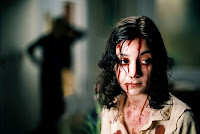 whether Hakan, the man who lives with Eli, is her father or her familiar. (In vampire myth, a familiar is a human who wishes to become a vampire by signing with the vampires through a blood oath.) Regardless, Hakan acts as Eli’s caretaker by slinking through the streets of Blackeberg in the middle of the night in search of a human to drain for blood. In each of his attempts, he screws up, and it provides several instances of black comedy in the film. But when Hakan can’t get the blood Eli needs to survive, she’s forced to go find it herself.
whether Hakan, the man who lives with Eli, is her father or her familiar. (In vampire myth, a familiar is a human who wishes to become a vampire by signing with the vampires through a blood oath.) Regardless, Hakan acts as Eli’s caretaker by slinking through the streets of Blackeberg in the middle of the night in search of a human to drain for blood. In each of his attempts, he screws up, and it provides several instances of black comedy in the film. But when Hakan can’t get the blood Eli needs to survive, she’s forced to go find it herself.
Watching such a small girl ravenously and violently latch onto a man who attempts to help her (she calls out to him, pretending she’s hurt, then buries her face and teeth into his neck), well, I jumped in my seat. It’s scary. And just as the audience begins to understand that, omg, she really is a vampire! she breaks her victim’s neck and leans over him sadly, almost apologetically, creating one of the many beautiful scene juxtapositions in the film, first exposing Eli as animal, then immediately highlighting her humanity. She kills because she needs to kill, not because she wants to.
From this moment on, the movie tackles several themes, one of which is violence, specifically the kid-on-kid viole nce Oskar experiences at the hands of his classmates, and how that plays against the vampire-on-human violence Eli’s responsible for. What does it say, for instance, that Eli, a killer by definition, experiences remorse for a necessary act of violence, while a group of young boys, most notably the leader of the pack, gets off on torturing and humiliating Oskar? As Eli and Oskar’s friendship develops, Eli ultimately convinces Oskar to stand up to the school bullies, and the consequences of his actions set the stage for the film’s finale.
nce Oskar experiences at the hands of his classmates, and how that plays against the vampire-on-human violence Eli’s responsible for. What does it say, for instance, that Eli, a killer by definition, experiences remorse for a necessary act of violence, while a group of young boys, most notably the leader of the pack, gets off on torturing and humiliating Oskar? As Eli and Oskar’s friendship develops, Eli ultimately convinces Oskar to stand up to the school bullies, and the consequences of his actions set the stage for the film’s finale.
At times, while watching the wonderful chemistry between the two young actors onscreen, it almost seemed as if the vampirism were a subplot rather than the main focus. The movie wants, after all, to tell us something about childhood, how lonely and alienated a child can feel, and how important it is to feel connected to someone. They toy with the idea of a romantic relationship somewhat—Oskar asks Eli “to go steady”—and she agrees, if it means keeping everything the same. This pretend-romance illustrates two things. One, that Oskar’s tale is a coming-of-age story, and two, that while Eli lives in the body of a twelve-year-old, she has in fact been “twelve” for quite a long time.
Without giving too much away, it’s important to mention both characters’ androgyn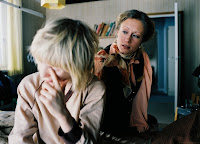 y. When Eli says at the beginning of the film, “I’m not a girl,” we naturally assume she means she’s a vampire. Is it possible she means something else? And if so, how does that change the dynamic of their interactions? A brief screen shot of Eli’s scarred genitalia forces us to ask these questions. Ultimately, the shot reminds us that Eli will forever remain as she is, an outcast in a child’s body, while Oskar will grow up, perhaps even grow out of his current status as “other.”
y. When Eli says at the beginning of the film, “I’m not a girl,” we naturally assume she means she’s a vampire. Is it possible she means something else? And if so, how does that change the dynamic of their interactions? A brief screen shot of Eli’s scarred genitalia forces us to ask these questions. Ultimately, the shot reminds us that Eli will forever remain as she is, an outcast in a child’s body, while Oskar will grow up, perhaps even grow out of his current status as “other.”
Let the Right One In takes a story about a vampire and makes it sweet, and in the end, takes that sweetness and turns it right on its head. Many people won’t read the ending as so dark, and I can see how one might even interpret it as a happy ending. But everything that comes before: Eli’s incessant quest for blood, Oskar’s increasing reliance on her strength and approval, their shared loneliness, and each character’s saving of the other’s life (both literally and metaphorically), frames the final scene (and possibly the entire film) as much more sinister than sweet.
One has to 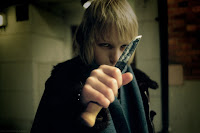 wonder if Oskar has any real idea about what’s in store for him by running away with Eli. In the end, Eli needs a new familiar, a human who will actively kill for her. While I believe Eli consciously manipulates Oskar by playing on his vulnerability, I don’t necessarily think Oskar, as naïve as he may come across to Eli, is unaware of Eli’s plan for him. It’s an exchange of sorts, and it’s about need—Oskar’s need to feel unconditionally accepted by someone, and Eli’s very practical need for blood. But it’s the film’s interrogation of “the monster within the human,” that works so well, ultimately positioning the weak, fear-based (and sympathetic) hero as the monster, a transformation that Oskar, unlike Eli, accepts willingly.
wonder if Oskar has any real idea about what’s in store for him by running away with Eli. In the end, Eli needs a new familiar, a human who will actively kill for her. While I believe Eli consciously manipulates Oskar by playing on his vulnerability, I don’t necessarily think Oskar, as naïve as he may come across to Eli, is unaware of Eli’s plan for him. It’s an exchange of sorts, and it’s about need—Oskar’s need to feel unconditionally accepted by someone, and Eli’s very practical need for blood. But it’s the film’s interrogation of “the monster within the human,” that works so well, ultimately positioning the weak, fear-based (and sympathetic) hero as the monster, a transformation that Oskar, unlike Eli, accepts willingly.
Speaking of invisible women, we’ve played the role quite well of late. Stay tuned, though; we’re in the midst of award season, and there’s plenty to say.
Coming Soon to a Theater Near You: The Invisible Woman?

Like a lot of women I know, superhero movies don’t really thrill me.
It wasn’t always this way. I have a clear memory of parading through the classrooms of my elementary school, when I was in fourth grade, dressed as Batman. I remember clearly that I felt powerful—not just because I was the Caped Crusader, but because my peers couldn’t tell if I was a boy or a girl.
Fast forward twenty years, when I enjoyed Batman Begins and looked forward to seeing what Maggie Gyllenahall would do for the role Katie Holmes tiptoed through. Turns out that Ms. Holmes wasn’t the problem with Rachel Dawes–Rachel Dawes was.
Although I had She-Ra action figures as a child, He-Man and Batman proved much more influential. While my childhood proclivities may be more revealing of my own personality than evidence of a lack of strong female characters, as an adult looking at representations of super-human power in the media, it’s more of a man’s world than ever.
Alyssa Rosenberg takes on the issue of female superheroes in the age of testosterone-fueled CGI blockbusters in her superb article “The Invisible Woman,” published this past September in The American Prospect. She talks of how comic books have numerous strong female characters—and a strong, growing female readership—but how Hollywood can’t seem to follow suit.
After a summer during which women flexed their box-office muscle, giving Sex and the City the highest-grossing opening for an R-rated comedy in movie history, it’s not inconceivable to think that a superheroine flick could draw on both the “girls’ night out” crowd and the already broad fan base for comic-book movies. That would be a great development, and not just for the studios that would experience a revenue bump of the kind provided by the Spider-Man and X-Men franchises. Superheroine movies could instantly provide badly needed quality roles for talented female actresses of varying ages and ethnicities, helping to address a gender imbalance in summer movies that’s caused critics like The New York Times’ Manohla Dargis (herself a minority in a world of mostly male reviewers) some serious heartburn.
Here’s hoping 2009 might bring some super-heroines whose shoes and sexuality aren’t her defining features.
Black Snake Moan: A Review in Conversation
 “This is some revolutionary shit. We’re tying up white women in Mississippi.” –John Singleton, on filming Black Snake Moan in the South
“This is some revolutionary shit. We’re tying up white women in Mississippi.” –John Singleton, on filming Black Snake Moan in the South
Why does the revolution necessitate wholesale exploitation of women?
Since Black Snake Moan was one of the initial movies (along with Hustle & Flow…maybe we should officially thank Craig Brewer for the inspiration) that made us want to start this site, it’s fitting that we discuss the movie in our first Review in Conversation segment.
Here’s the IMDb summary:
In Mississippi, the former blues man Lazarus is in crisis, missing his wife that has just left him. He finds the town slut and nymphomaniac Rae dumped on the road nearby his little farm, drugged, beaten and almost dead. Lazarus brings her home, giving medicine and nursing and nourishing her like a father, keeping her chained to control her heat. When her boyfriend Ronnie is discharged from the army due to his anxiety issue, he misunderstands the relationship of Lazarus and Rae, and tries to kill him. (Claudio Carvalho)
Before I address the film’s atrocious sexism, which the above summary characterizes well, I’d like to say what I love about BSM. The music, first and foremost, is outstanding. Brewer calls this a movie about the blues, and I’d like to take that a step further and say the movie is the blues. Or it tries to be, at least. The movie and its story are too small, conflicted, and tone-deaf to achieve greatness. It tries to be the blues and ends up being a blues music video, where Lazarus (Samuel L. Jackson) is the tortured and tired star, and Rae (Christina Ricci) is the video vixen, shaking her ass for the camera.
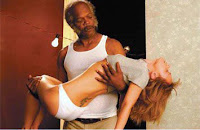 This is a movie that I want to love. It’s gritty, unique, and aware of class and race—a rare combination. However, there is no female perspective in the movie. Is it really too much to ask for a sharp film to also be sharp about gender? Is it right for a film like BSM to claim gender as a theme, while not really exploring women at all? Rae is the only female character (brief appearances by Lazarus’ wife, Rae’s mother, and a kind pharmacist easily fit into the angel/monster dichotomy), but she isn’t quite a real person. What is wrong with her? She is talked about as a nymphomaniac, and has strange, demonic fits of desire, but she’s really a victim of rape and abuse. Lazarus, whose trauma is that his wife aborted his baby and left for his younger brother, takes it upon himself to “cure” her by chaining her to a radiator. Even if the movie isn’t to be taken literally (but as a metaphor of sorts), why are the other characters so human and she so other, so animal?
This is a movie that I want to love. It’s gritty, unique, and aware of class and race—a rare combination. However, there is no female perspective in the movie. Is it really too much to ask for a sharp film to also be sharp about gender? Is it right for a film like BSM to claim gender as a theme, while not really exploring women at all? Rae is the only female character (brief appearances by Lazarus’ wife, Rae’s mother, and a kind pharmacist easily fit into the angel/monster dichotomy), but she isn’t quite a real person. What is wrong with her? She is talked about as a nymphomaniac, and has strange, demonic fits of desire, but she’s really a victim of rape and abuse. Lazarus, whose trauma is that his wife aborted his baby and left for his younger brother, takes it upon himself to “cure” her by chaining her to a radiator. Even if the movie isn’t to be taken literally (but as a metaphor of sorts), why are the other characters so human and she so other, so animal?
Response by Stephanie R.
I, too, fell in love with the music in this film. It complements the key themes—race and class, as you mentioned, religion, and I’d also take it a step further to include sex. The scenes with Ricci shaking her ass for the camera are wonderfully sexy, and I found myself wavering back and forth during those scenes, wondering, is this just another female character being exploited by the camera? Or, is this a female character finally owning her sexuality?
Early on, she’s portrayed as a woman who’s at the mercy of her untamable sexual desires, and I didn’t ever get the feeling that she enjoyed them. She’s often shown squirming around on the ground, rubbing her hands all over her body, and moaning, like she’s struggling to fend off an attack. It’s at that point that she must find someone, anyone to screw, in order to make that feeling go away.
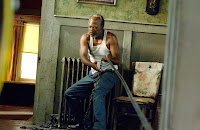 Later though, after Lazarus “cures” her by wrapping a giant chain around her waist and attaching it to a radiator, Rae is allowed to enter society again, showing up at a bar with Lazarus, drinking, rubbing up against everyone on the dance floor while Lazarus watches her from the stage, almost approvingly. What’s going on here? I truly want to read this as much more complicated than a man giving a woman permission to flaunt her sexuality, and I think it is.
Later though, after Lazarus “cures” her by wrapping a giant chain around her waist and attaching it to a radiator, Rae is allowed to enter society again, showing up at a bar with Lazarus, drinking, rubbing up against everyone on the dance floor while Lazarus watches her from the stage, almost approvingly. What’s going on here? I truly want to read this as much more complicated than a man giving a woman permission to flaunt her sexuality, and I think it is.
But I also can’t help getting a little unnerved by the frivolity with which her sexuality is treated earlier in the film, when she’s portrayed as nothing more than the town whore. (At one point, the local mechanic says, “It’s already noon, Rae. Do you think those shorts should still be on?”) And when she’s described as “having the sickness” by another character (meaning nymphomania), it’s impossible not to think about the double-standard we still hold for men and women, especially when it comes to sexual desires.
As you mentioned, she is portrayed as “other,” often animalistic in her sexual conquests. Since I don’t think a film like this would work at all if a man were the one with the sexual “disease” (it’s natural for men to have uncontrollable sex drives, after all) then what does one make of using the myth of nymphomania to drive the plot? (See Peter Green’s “All Sexed Up,” a review of Carol Groneman’s 2000 book Nymphomania: A History, for a brief discussion of the myth.)
Response by Amber L.
I agree that the scene in the bar was very sexy, and I think I agree with what you said about that being a moment of Rae owning her sexuality. I think we’re supposed to understand that scene as a very important moment in which both characters are owning something that they’d lost—or lost control of. For whatever reason, Lazarus had lost his music (and I suspect it had to do with his wilting marriage), and Rae had lost control of her sexuality. However, that scene was exhilarating, and I think it has to do with reclamation and individual victory.
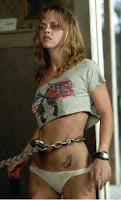 But back to the way gender and sex intersect. If nymphomania is itself largely fictitious, the strange way Rae’s fits were portrayed—moments in the film that were suspended between fear and comedy—reveals some of the ideological confusion of the film. If not for her nearly-naked body, battered and bruised and constantly displayed, I might have more sympathy for the film’s motivations. Add that to Rae’s moment of catharsis where she beats the shit out of her mother with a mop handle (for allowing Rae to be raped, either by her father or another male figure in her home), and we see women destroyed by sex who we’re supposed to sympathize with.
But back to the way gender and sex intersect. If nymphomania is itself largely fictitious, the strange way Rae’s fits were portrayed—moments in the film that were suspended between fear and comedy—reveals some of the ideological confusion of the film. If not for her nearly-naked body, battered and bruised and constantly displayed, I might have more sympathy for the film’s motivations. Add that to Rae’s moment of catharsis where she beats the shit out of her mother with a mop handle (for allowing Rae to be raped, either by her father or another male figure in her home), and we see women destroyed by sex who we’re supposed to sympathize with.
The final topic I want to bring up is religion. We can’t deny the role Christianity plays in the film. From the name of the main character to the supporting cast (which includes a preacher), the issue of faith (and a very certain brand of faith) comes up again and again. If the movie is a metaphor for “anxiety, fear, and unconditional love,” according to Brewer himself, then religion is the element that holds it all together. The instantiations of religion, however, are clunky at best; the radiator is God, the chain is faith, et cetera. I don’t really know where to go from here, except to acknowledge the large role of religion, although it plays out in hackneyed ways.
Response by Stephanie R
While I would like to see both characters in this film actually achieve some level of reclamation and individual victory, I think it fails for the most part, but the film especially fails Rae. She remains “chained” in a metaphorical sense, even in the final scenes. I don’t believe her character discovers much, or achieves much of an arc; she remains, for me, completely static. In fact, the film pretty much uses her as a vehicle to showcase the success of Lazarus, (which is yet another example of female exploitation that Brewer has either no awareness of or no desire to address).
I was left feeling no hope for Rae in that final scene—she’s imprisoned, (in a stuffy car, surrounded by semi-trucks) stuck in a relationship with a man who’s essentially a child needing to be coddled, with only the memory of her radiator-chain to keep her from jumping from the vehicle and fucking her way across the interstate. But Lazarus has his music again. He’s managed to overcome his anger about his wife leaving him, and he’s even got a nice new chick to look after him. See how chaining up a white woman in Mississippi can revolutionize an entire worldview?
The truth is I never gave a shit about Rae. I could’ve cared for her, if Brewer hadn’t used her sexuality against her—it’s filmed as if the abuse she suffers is deserved. (See what you get when you go around whoring yourself? Tsk, tsk.) By the time we get to know her character, when, as you mentioned, she divulges her history of sexual abuse, then beats the shit out of her mother with a mop handle, it’s way too late for sympathy. By that point, Brewer has already managed to turn a young woman’s sexuality into a cross between sketch comedy and porn, where nothing about it feels real.
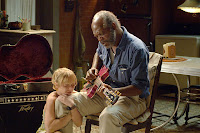 In that moment of catharsis with her mother, I found myself detached. Instead of sympathizing with Rae and coming to some kind of realization myself, I just rolled my eyes at the ridiculous, clichéd consequences of her abuse—girl gets raped by father-figure while mother does nothing to stop it, girl develops low self-esteem, girl becomes town slut, girl develops a fictional sex disease, girl gets chained to radiator by religious black man. Wait, what? Ah religion, how you never cease to reinforce the second-class citizenship of women, perpetually punishing them for their godless desire to fuck.
In that moment of catharsis with her mother, I found myself detached. Instead of sympathizing with Rae and coming to some kind of realization myself, I just rolled my eyes at the ridiculous, clichéd consequences of her abuse—girl gets raped by father-figure while mother does nothing to stop it, girl develops low self-esteem, girl becomes town slut, girl develops a fictional sex disease, girl gets chained to radiator by religious black man. Wait, what? Ah religion, how you never cease to reinforce the second-class citizenship of women, perpetually punishing them for their godless desire to fuck.
So Rae is possessed by an evil sex demon, and, at one freaky moment, Lazarus’s ex-wife. Lazarus and his brother are Cain and Abel. There’s adultery, lust, preachers, fire-and-brimstone, bible passages, and judgmental townsfolk. Basically, the religious themes receive the same clichéd treatment as women’s sexuality. Rae is pretty much “saved” by Lazarus, and Lazarus pretty much gets his shit together and “rises from the dead” (as Lazarus in the bible).
And, after this conversation, I’m starting to wonder if I’m the problem, if I made the mistake of taking this film seriously, when what it really wants to be is one big sensationalist metaphor. A metaphor for what, though? I’ll conclude with something Brewer says in an interview.
“I’m not writing from a place of progress. I’m not writing a movie that I want people to necessarily intellectualize. And I think that really messes with people who feel that they need to make a statement against this, and they don’t quite know what it is they’re against. Because man alive, you look at this imagery on this poster, and I’m so obviously banging this drum. It’s like, you really believe that I believe this? That women need to be chained up? Can we not think metaphorically once race and gender are introduced?”
Rent Black Snake Moan from Netflix
Read Carol Groseman’s article, “Nymphomania: The Historical Construction of Female Sexuality,” published in Signs: Journal of Women in Culture and Society
Read the Salon.com interview with Craig Brewer
A Few Good Women
In honor of Veteran’s Day, I thought I’d highlight female veterans and some movies featuring female soldiers.
The news about female vets has been plentiful as of late, and none of it particularly good or encouraging. More female veterans than ever are homeless, and government-sponsored housing is in short supply, according to the Air Force Times.
The homeless female veteran is a relatively new phenomenon because only recently have so many women — more than 190,000 in Iraq and Afghanistan alone — been serving in the military, said Todd DePastino, a historian at Waynesburg University who wrote a book on the history of homelessness.The number of homeless female veterans have gone up — from 3 percent of all homeless veterans a decade ago to 5 percent, the VA says.
“It’s a national embarrassment,” said Paul Rieckhoff, executive director of Iraq and Afghanistan Veterans of America.
Last March, Salon.com published an article titled “The Private War of Women Soldiers” about widespread sexual assault in the military, which has currently serving women refusing to leave their cots at night for fear of being raped on their way to the latrines. Columbia professor Helen Benedict also writes of the intensity of dealing with Post-Traumatic Stress Syndrome (PTSD) from combat and sexual assault.
Not everyone realizes how different the Iraq war is for women than any other American war in history. More than 160,500 American female soldiers have served in Iraq, Afghanistan and the Middle East since the war began in 2003, which means one in seven soldiers is a woman. Women now make up 15 percent of active duty forces, four times more than in the 1991 Gulf War. At least 450 women have been wounded in Iraq, and 71 have died — more female casualties and deaths than in the Korean, Vietnam and first Gulf Wars combined. And women are fighting in combat.
Officially, the Pentagon prohibits women from serving in ground combat units such as the infantry, citing their lack of upper-body strength and a reluctance to put girls and mothers in harm’s way. But mention this ban to any female soldier in Iraq and she will scoff.
“Of course we were in combat!” said Laura Naylor, 25, who served with the Army Combat Military Police in Baghdad from 2003-04. “We were interchangeable with the infantry. They came to our police stations and helped pull security, and we helped them search houses and search people. That’s how it is in Iraq.”
Women are fighting in ground combat because there is no choice. This is a war with no front lines or safe zones, no hiding from in-flying mortars, car and roadside bombs, and not enough soldiers. As a result, women are coming home with missing limbs, mutilating wounds and severe trauma, just like the men.
With the surge of women serving in the military, there doesn’t seem to be a correlative rise in female soldiers depicted in film. Here are a few movies featuring female soldiers. All plot summaries are from IMDb.
Courage Under Fire (1996)
The pilot of a rescue copter, Captain Karen Walden, died shortly before her helicopter crew was rescued after it crashed in Desert Storm. It first appears that she made a spectacular rescue of a downed helicopter crew, then held her own crew together to fight off the Iraqis after her copter crashed. LT Colonel Serling, who is struggling with his own demons from Desert Storm is assigned to investigate and award her the Medal of Honor. But some conflicting accounts from her crew and soldiers in the area, cause him to be question whether she deserves it. Written by Brian W Martz {B.Martz@Genie.com}
Rent Courage Under Fire from Netflix
In this dramatic courtroom thriller, Lt. Daniel Kaffee, a Navy lawyer who has never seen the inside of the courtroom, defends two stubborn Marines who have been accused of murdering a colleague. Kaffee is known as being lazy and had arranged for a plea bargain. Downey’s Aunt Ginny appoints Cmdr. Galloway to represent him. Also on the legal staff is Lt. Sam Weinberg. The team rounds up many facts and Kaffee is discovering that he is really cut out for trial work. The defense is originally based upon the fact that PFC Santiago, the victim, was given a “CODE RED”. Santiago was basically a screw-up. At Gitmo, screw-ups aren’t tolerated. Especially by Col. Nathan Jessup. In Cuba, Jessup and two senior officers try to give all the help they can, but Kaffee knows something’s fishy. In the conclusion of the film, the fireworks are set off by a confrontation between Jessup and Kaffee. Written by Matt Curtolo {curt@epix.net}
Rent A Few Good Men from Netflix
When a crusading chairperson of the military budget committee pressures the would be Navy secretary to begin full gender integration of the service, he offers the chance for a test case for a female trainee in the elite Navy SEALS commando force. Lt. Jordan O’Niel is given the assignment, but no one expects her to succeed in an inhumanly punishing regime that has a standard 60% dropout rate for men. However, O’Niel is determined to prove everyone wrong. Written by Kenneth Chisholm {kchishol@execulink.com}
Rent G.I. Jane from Netflix
The day after they get the word they’ll go home in two weeks, a group of soldiers from Spokane are ambushed in an Iraqi city. Back stateside we follow four of them – a surgeon who saw too much, a teacher who’s a single mom and who lost a hand in the ambush, an infantry man whose best friend died that day, and a soldier who keeps reliving the moment he killed a civilian woman. Each of the four has come home changed, each feels dislocation. Group therapy, V.A. services, halting gestures from family and colleagues, and regular flashbacks keep the war front and center in their minds. They’re angry, touchy, and explosive: can a warrior find peace back home? Written by {jhailey@hotmail.com}
Rent Home of the Brave from Netflix
 Lioness (2008)
Lioness (2008)
Lioness presents the untold story of the first group of women soldiers in US history to be sent into direct ground combat, in violation of official policy. Told through intimate accounts, journal excerpts, archive footage, as well as interviews with military commanders, the film follows five women who served together for a year in Iraq. With captivating detail, this probing documentary reveals the unexpected course of events that began with using US women soldiers to defuse tensions with local civilians, but resulted in the women’s fighting in some of the bloodiest counter-insurgency battles of the war. Together the women’s candid narratives and scenes from their lives back home form a portrait of the emotional and psychological effects of war from a female point of view. Lioness is the first film to bridge the gap between perception and reality of the role women in the military are playing in Iraq, capturing an historical turning point for American society.
Read an interview with filmmakers Meg McLagan and Daria Sommers.
_____________
Have we missed some good ones? Compared with the problems female vets face, most of these movies feel like token representations. Demi Moore actually won a Razzie for Worst Actress in G.I. Jane. I’ve left out the many depictions of female soldiers in science fiction films and TV shows (Starbuck from Battlestar Gallactica immediately comes to mind), perhaps unfairly. Tell us movies we’ve left out in the comments section.
‘One Woman, One Vote’: A Documentary Review
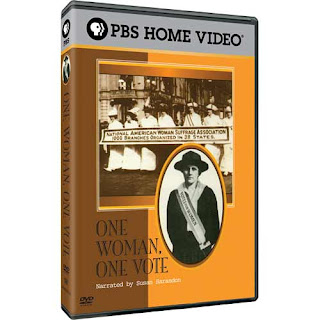 Seneca Falls. Susan B. Anthony. Elizabeth Cady Stanton. Alice Paul. Lucy Burns. Iconic American names that we recognize from our last history course, but often without knowledge of the full extent of their courage and suffering. The suffrage movement is one filled with small victories, setbacks, and defeats, and with men and women of often clashing ideas and ideologies.
Seneca Falls. Susan B. Anthony. Elizabeth Cady Stanton. Alice Paul. Lucy Burns. Iconic American names that we recognize from our last history course, but often without knowledge of the full extent of their courage and suffering. The suffrage movement is one filled with small victories, setbacks, and defeats, and with men and women of often clashing ideas and ideologies.
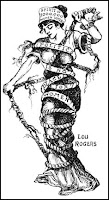 Women’s suffrage was a 72-year movement that finally attained nation-wide victory in 1920 with the ratification of the 19th constitutional amendment prohibiting sex discrimination at the polls. Up to this point, women met, organized, marched, fought amongst themselves, lobbied, and protested. They were threatened, ridiculed, attacked, beaten, tried, arrested, and placed in solitary confinement for their actions. In retaliation, they fought harder. They organized hunger strikes in prison. They surrounded the White House in protest, despite angry mobs of men who dragged them to the ground and tore not only their banners, but also clothing from their bodies.
Women’s suffrage was a 72-year movement that finally attained nation-wide victory in 1920 with the ratification of the 19th constitutional amendment prohibiting sex discrimination at the polls. Up to this point, women met, organized, marched, fought amongst themselves, lobbied, and protested. They were threatened, ridiculed, attacked, beaten, tried, arrested, and placed in solitary confinement for their actions. In retaliation, they fought harder. They organized hunger strikes in prison. They surrounded the White House in protest, despite angry mobs of men who dragged them to the ground and tore not only their banners, but also clothing from their bodies.
One of the more shocking discoveries I had from watching One Woman, One Vote was that women were not united in the cause of suffrage. There were a number of women who believed that politics were corrupt, and that women would only participate in the corruption, and sully their clean, domestic image, by voting. There was even strong disagreement amongst the suffragettes; they divided and formed separate groups on different occasions, opposing each others’ strategies and tactics for earning the vote, and finally unified when ratification of the amendment seemed inevitable. There were many diverse opinions and motivations driving the movement and its opposition, including racism, temperance, religion, and cultural norms.
 The documentary was made in 1995, but only the graphics seem dated (and, despite the fact that One Woman, One Vote is part of the PBS American Experience series, the film has no official website). Susan Sarandon narrates, and the film is full of varied voices, letters, film reels, photos, and cartoons. There are great clips of historic songs throughout, too, which are often funny, incisive, and scathing. I learned so much about a part of American and women’s history that is so often summarized into a single paragraph.
The documentary was made in 1995, but only the graphics seem dated (and, despite the fact that One Woman, One Vote is part of the PBS American Experience series, the film has no official website). Susan Sarandon narrates, and the film is full of varied voices, letters, film reels, photos, and cartoons. There are great clips of historic songs throughout, too, which are often funny, incisive, and scathing. I learned so much about a part of American and women’s history that is so often summarized into a single paragraph.
Here are a few highlights of the women who made the movement.
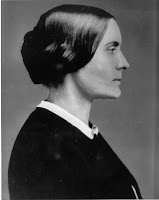 On November 5, 1872, Susan B. Anthony led a dozen women to the polls in Rochester, New York, and convinced the worker there to allow her and the others to vote—despite the fact that it was against the law. Four hours later, U.S. Marshals arrested and handcuffed Anthony. She was later convicted of a federal crime by an all-male jury–after being forbidden to testify on her own behalf (women were deemed incompetent to testify because of their sex). Before her sentencing, however, she was permitted a statement:
On November 5, 1872, Susan B. Anthony led a dozen women to the polls in Rochester, New York, and convinced the worker there to allow her and the others to vote—despite the fact that it was against the law. Four hours later, U.S. Marshals arrested and handcuffed Anthony. She was later convicted of a federal crime by an all-male jury–after being forbidden to testify on her own behalf (women were deemed incompetent to testify because of their sex). Before her sentencing, however, she was permitted a statement:
“In your ordered verdict of guilty, you have trampled underfoot every principle of our government: my natural rights, my civil rights, my political rights. I have been tried by law made by men, interpreted by men, administered by men, in favor of men, and against women. May it please, your honor, I shall never pay a dollar of your unjust penalty. Resistance to tyranny is obedience to God.”
 African American women were quite unified in their support of suffrage. However, mainstream groups were seeking the support of Southern Democrats, who strongly opposed suffrage for black women, and thus largely left black women out of their cause. Mary Church Terrell was one of the few black women invited to speak at national conventions, and there she urged white suffragists not to forget black women:
African American women were quite unified in their support of suffrage. However, mainstream groups were seeking the support of Southern Democrats, who strongly opposed suffrage for black women, and thus largely left black women out of their cause. Mary Church Terrell was one of the few black women invited to speak at national conventions, and there she urged white suffragists not to forget black women:
“Not only are colored women handicapped on account of their sex, they are everywhere mocked on account of their race. We are asking that our sisters of the dominant race do all in their power to include in their resolutions the injustices to which colored people are victims.”
Despite the efforts of Terrell and other African American leaders, they never enjoyed mainstream acceptance from the suffrage movement. Regardless, they organized and grew their supporters to half a million members, including active support from men.
 Elizabeth Cady Stanton, who first called for women’s rights at Seneca Falls (the right to vote was her most radical demand; the group met to call for property rights, divorce rights, and a woman’s right to her children), told her friend Susan B. Anthony that as she grew older, she grew more radical. Their relationship is widely considered one of the greatest relationships of the 19th century, and Stanton’s radicalism seems to be one of the few areas of disagreement–though it did not end their friendship. When Stanton was in her 70s, frustrated by women who still refused to join the suffrage movement, she denounced the church as responsible for the oppression of women.
Elizabeth Cady Stanton, who first called for women’s rights at Seneca Falls (the right to vote was her most radical demand; the group met to call for property rights, divorce rights, and a woman’s right to her children), told her friend Susan B. Anthony that as she grew older, she grew more radical. Their relationship is widely considered one of the greatest relationships of the 19th century, and Stanton’s radicalism seems to be one of the few areas of disagreement–though it did not end their friendship. When Stanton was in her 70s, frustrated by women who still refused to join the suffrage movement, she denounced the church as responsible for the oppression of women.
“The Bible teaches that woman brought sin and death into the world. I don’t believe that any man ever talked with God. The Bible was written by man, out of his love of domination.”
She rewrote every section of the Bible that degraded women, and published The Woman’s Bible, which was translated into six languages. The Woman’s Suffrage Association denounced the work, and rebuked Stanton. After her death, Stanton’s daughter, Harriet Blatch, led the movement.
 Alice Paul earned numerous academic degrees in her lifetime, and also served numerous prison sentences for acts of civil disobedience in her campaign for women’s suffrage. When she arrived in Washington in 1913, she was one of the few women in the United States who held a doctorate degree in political science. While in prison she led hunger strikes, and was tortured with forced-feedings:
Alice Paul earned numerous academic degrees in her lifetime, and also served numerous prison sentences for acts of civil disobedience in her campaign for women’s suffrage. When she arrived in Washington in 1913, she was one of the few women in the United States who held a doctorate degree in political science. While in prison she led hunger strikes, and was tortured with forced-feedings:
“Dear Mama,
The forcible feeding was terrible. They tied me to a chair because I struggled. One wardress sat astride my knees, two others held my arms and hands while two doctors forced a tube five or six feet long through my nose, like driving a stake into the ground.”
Rather than defeat her, the experience only made Paul more determined to devote her life to the suffrage movement. Among her many accomplishments were the organization of a parade that essentially upstaged the inauguration of newly-elected president Woodrow Wilson and caused a riot in the streets that brought out the U.S. Cavalry, and a “perpetual delegation” of women who picketed outside the White House, six days a week, in which women from all backgrounds stood silently with banners protesting the administration’s refusal to support a federal amendment to enfranchise women, and even outrageously mocking the president’s hypocrisy. Finally, police began to arrest the silent protesters, who were regularly being physically attacked, and charged them with obstructing traffic and imprisoned them–sometimes for months at a time.
The year was 1917. It took an additional three years for the 19th amendment to be passed and ratified by all of the states.
Remember the women who fought for women like us. We’ve only had the vote for 88 years. Exercise your right: Vote today.
Rent One Woman, One Vote from Netflix.
Purchase the DVD from PBS.
Elizabeth Banks on a Porno
The number two movie at the box office this past weekend was Kevin Smith’s comedy Zack and Miri Make a Porno. Classically-trained actress, Elizabeth Banks, calls the role the best she’s ever played, and enthuses that director Kevin Smith “actually put a woman’s name in the title of a movie.”
Yeah, but he also put the word “porno” as the title’s direct object.
Read the LA Times interview with Banks, titled “Actress Elizabeth Banks is as versatile as they’ll let her be.”
About Banks, Smith says “She’s got that ‘guy’s girl’ thing going for her, so she can roll with dudes and be funny, but scrape that away and you realize this chick is way better than an R-rated comedy.”
I’ve heard the movie is funny and sweet, but I can’t help but to be skeptical of a celebration of this role, particularly with the bizarre and sexist statements that pop up in the very positive article.
Banks, like many actors in Hollywood, struggles with her desire to be taken seriously and do important work, but to be successful, too.
“You can go be in a female-driven indie and make two cents and maybe get an Independent Spirit Award, but then you can’t pay your car lease,” she says. “So Vince Vaughn makes movies, he needs a girl to be in it with him, it might be me.”
Ripley’s Pick: Rachel Getting Married
Welcome to our new feature, “Ripley’s Pick of the Week.” Each week, we’ll showcase a film that passes Ripley’s Rule, aka The Bechdel Rule.
Ripley’s Pick of the Week
Rachel Getting Married. Starring Anne Hathaway, Rosemarie DeWitt, Bill Irwin, Tunde Adebimpe, and Debra Winger. Written by Jenny Lumet. Directed by Jonathan Demme.

Rachel Getting Married isn’t your typical wedding movie. The film takes place over the course of a weekend, where the audience watches Rachel’s wedding unfold, complete with uncomfortable wedding speeches, recovering addicts, and live music playing in the background at all times. But the film isn’t about Rachel’s wedding—it’s about the awkward and often heartbreaking family dynamics at play, particularly among Rachel (Rosemarie DeWitt), her perpetually-rehabbed-since-adolescence sister Kym (Anne Hathaway), and their absent mother Abby, played (amazingly) by Debra Winger.
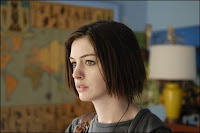 at home, in the typical heavy black eyeliner and choppy haircut reserved especially for onscreen female addicts, it’s immediately obvious that her family views her as out of control and unpredictable—for good reason. She demands to be the maid of honor. She references her twelve-step program during her rehearsal-dinner speech. She seduces the best man (who she initially meets in a Narcotics Anonymous meeting) in the first fifteen minutes of the movie.
at home, in the typical heavy black eyeliner and choppy haircut reserved especially for onscreen female addicts, it’s immediately obvious that her family views her as out of control and unpredictable—for good reason. She demands to be the maid of honor. She references her twelve-step program during her rehearsal-dinner speech. She seduces the best man (who she initially meets in a Narcotics Anonymous meeting) in the first fifteen minutes of the movie.  sulates the bad-girl cliché, Rachel embodies the opposite. She’s sweet, in love, studying Psychiatry, and even her future in-laws describe her as an angel. Rachel’s earnestness, particularly in the scenes with her fiancé and her mother (it’s clear she craves her mother’s love and approval), works well juxtaposed with Kym’s constant biting sarcasm. While Kym seems to steal the attention of her parents by playing up her wildness and forcing them to acknowledge her, Rachel seeks it more sincerely, for instance by subtly letting her mother know she’d like her to contribute more than just the flower arrangements to her wedding ceremony.
sulates the bad-girl cliché, Rachel embodies the opposite. She’s sweet, in love, studying Psychiatry, and even her future in-laws describe her as an angel. Rachel’s earnestness, particularly in the scenes with her fiancé and her mother (it’s clear she craves her mother’s love and approval), works well juxtaposed with Kym’s constant biting sarcasm. While Kym seems to steal the attention of her parents by playing up her wildness and forcing them to acknowledge her, Rachel seeks it more sincerely, for instance by subtly letting her mother know she’d like her to contribute more than just the flower arrangements to her wedding ceremony. he audience recognizes from the beginning that something isn’t quite right with this family—why is Kym in and out of rehab? Why do their divorced parents feel so awkward around each other? And why does Abby seem so obviously uncomfortable around her daughters, especially Kym? It’s not long before Kym, in her NA meeting, reveals the family tragedy haunting their family. The scene works well, and Hathaway is brilliant here, because, in Kym’s telling of the tragedy, we begin to see her vulnerability, and the audience gains a broader understanding of the guilt, sadness, even the self-loathing that each family member struggles with.
he audience recognizes from the beginning that something isn’t quite right with this family—why is Kym in and out of rehab? Why do their divorced parents feel so awkward around each other? And why does Abby seem so obviously uncomfortable around her daughters, especially Kym? It’s not long before Kym, in her NA meeting, reveals the family tragedy haunting their family. The scene works well, and Hathaway is brilliant here, because, in Kym’s telling of the tragedy, we begin to see her vulnerability, and the audience gains a broader understanding of the guilt, sadness, even the self-loathing that each family member struggles with.
Watch the trailer here.
